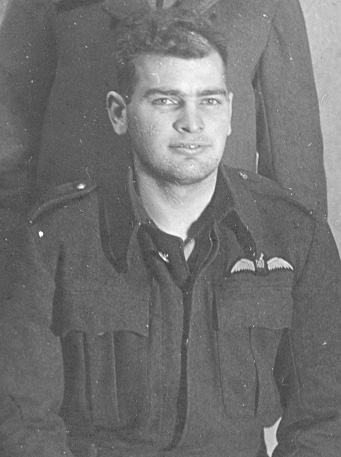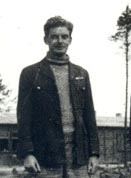
Just before 9 p.m., on March 24, Les “Johnny” Bull became the first man through the trapdoor under the stove in Room 23 of Hut 104 on his way to open the exit shaft to freedom. In Tunnel “Harry” itself, Bull stretched himself face down on the trolley, and dog-paddled his way to Piccadilly, the first half-way house, a hundred feet up the tunnel. Once there, he jerked the rope for Johnny Marshall, who would act as underground conductor for the first hour and once his 10 men were through would exit the tunnel in the number 11 spot. The two men repeated the travel sequence past the Leicester Square half-way house and at the base of the exit shaft climbed to the top of the shaft to make the final cut through the ceiling boards and sod beyond in the pine forest.
It took Bull and Marshall nearly 30 minutes to break through the ceiling since the planks had swollen with dampness and frozen in the sub-zero temperatures. They’d stripped off the civilian clothing that would disguise them at the train station and in their underwear finally pulled the wood free and poked into the grass roots and snow above. That’s when the two discovered Tunnel “Harry” was 10 feet short of the pine forest and in plain view of the goon tower and fence-line sentries 40 feet away. They improvised and rigged a rope from the exit shaft hole to a blind in the woods and implemented a tug-on-the-rope system for each kriegie to interpret as an all-clear signal for the dash to the woods.

Of all the legendary personal stories involving escapers on the 360-foot trolley ride to the exit shaft and beyond, among the more compelling involved Canadians Hank Birkland and Briton Bob Nelson (who later immigrated to Canada). As some of the hard-arsers rolled their way through “Harry” some (because of their nervousness, claustrophobia, or just because they were so bulky with clothing, bundled blankets and provisions) inadvertently bumped the tunnel timber causing cave-ins.
Tom Kirby-Green, 13th in the tunnel, accidentally derailed the trolley between Piccadilly and Leicester Square breaking some of the bunk boards in the tunnel walls and sand began to pour in and bury him. Digger Hank Birkland realized the problem, crawled to Kirby-Green and freed him from the sand. Bob Nelson remembered a similar incident.
“When I was hauling (James Long) through the tunnel, the roof fell on top of him,” Nelson said. “I had to pull him out and then when he got past me, I then had to go up the tunnel on my elbows and toes to repair the roof and clear the sand.”
The difficulty of manoeuvring broad-shouldered men wrapped with as much clothing as they might need to fend off the cold and hauling enough food to fuel their progress, meant the narrow passageways became even narrower. At the trapdoor entrance, Robert Ker-Ramsey and Tony Pengelly made the difficult decision to trim back hard-arsers’ layers of clothing and carrying gear. The hard-arsers understood the safety factor, but feared the impact on their survivability. Keith Ogilvie’s thoughts summed up their fears.
“They hoped for the sake of fellas like myself, going hard-ass, that our chances of hiding out in the woods or getting something to eat would be a little better,” Ogilvie said, “but (once out and on the run) it was really cold and frosty.”
Through the night the flow of escapers continued until nearly 80 were either out of the tunnel or already on the run. The months and years of planning and trial and error had yielded not 200 escapers outside the wire (as Bushell had hoped), but it had delivered sufficient numbers to divert as many as 70,000 German troops, police and civilians – in the hours that followed – in an all-out effort to recapture the escapers.